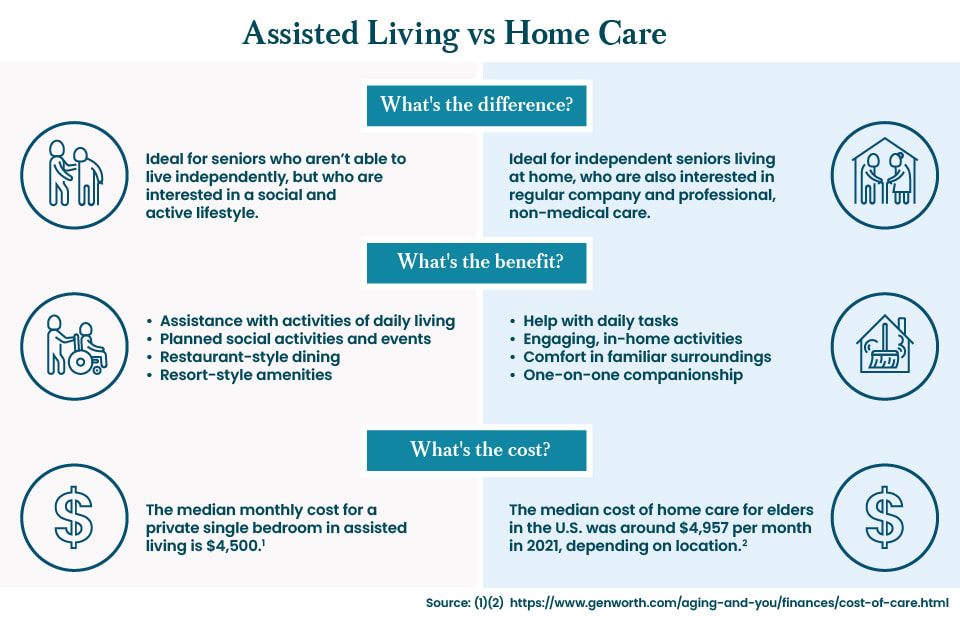Make the best senior care decision

Assisted Living vs. Home Care: What's the Difference?

When it becomes clear that an elderly family member needs daily care, deciding what to do next might seem overwhelming. Assisted living and home care are two common options that can provide the additional needed support.
Key Takeaways
- Assisted living facilities combine housing, support services, and health care. These communities are primarily intended for active seniors who aren’t able to live independently.
- Home care allows seniors to remain in their homes. In-home caregivers can provide regular company and professional supportive care.
- Assisted living may be a better financial choice. If your loved one requires more than five hours of home care per day, assisted living might be a more affordable option.
- Consider the housing needs of your loved one, their level of independence, and their budget. These factors are key in deciding between assisted living versus home care.
Both choices are popular. Three out of four adults ages 50+ stated that they would like to continue to age at home.[01] Meanwhile, many family members report that while their parent or relative may have initially resisted the idea of assisted living, they quickly grew to love their new community.
The primary differences between assisted living versus home care are where the individual receives support and the overall costs associated with each type of care. Assisted living communities offer care, meals, social opportunities, and housing all in an apartment-style environment, while home care delivers comparable services directly within seniors’ homes.
Learn more about the staff specialties, costs, and services included in these two options for senior support to help guide you in deciding between assisted living versus home care for your loved one.
What is assisted living?
Assisted living facilities provide housing and care services to active seniors who aren’t able to live independently. This type of care combines housing, support services, and health care if needed.
These communities help seniors with activities like bathing, dressing, and eating, but they don’t provide ongoing skilled nursing care.
Many assisted living communities for seniors offer numerous supportive care options, including the following:
- Medication management
- Meal services
- Housekeeping or laundry services
- Social activities
- Assistance with activities of daily living
Benefits of assisted living
Many elderly people might prefer to stay at home longer because they fear change, says Michelle Aweshah, a regional manager at A Place for Mom (APFM). However, over time, assisted living communities can feel like home, too.
Seniors in assisted living, as well as their loved ones, can look forward to multiple benefits:
Flexibility
Assisted living can provide either short-term or long-term care, depending on your needs — it doesn’t have to be a permanent decision.
“Some people feel assisted living might be their ‘final place,’ and are afraid that they won’t like it once they move,” says Aweshah. “The great news is, in most cases, assisted living communities only require a 30-day notification of a move, even if you signed to stay a year.”
Round-the-clock care
In addition to providing flexibility, assisted living offers care day and night, as needed. The various skills of staff members in assisted living play a pivotal role in supporting the well-being and safety of residents.
“There are aides on staff around the clock to assist with personal care needs,” says Aweshah. “Most communities also have nurses on-site, as well as mobile services for physician appointments, therapy services, and more.”
Social activities and services
“For many, being home may feel independent, but if they’re unable to drive, don’t visit friends as often anymore, or don’t eat as well, this can be very isolating and can lead to depression,” says Aweshah. “Being ‘independent’ can quickly become a detriment to quality and longevity of life.”
Assisted living communities provide transportation, nutritious foods, games, and social activities, which are all very popular with residents.
Additional benefits of assisted living can include a host of helpful amenities:
- Beauty salons and barber shops
- Concierge services
- Gyms
- Game rooms
- Movie theaters
If you’ve decided assisted living is the right fit, touring can help you compare communities and ask key questions. Use our downloadable resource to keep track of notes, observations, and next steps.
Download the assisted living touring checklist >

Let our care assessment guide you
Our free tool provides options, advice, and next steps based on your unique situation.
What is home care?
Home care offers companionship, transportation, and daily assistance for seniors living at home. One way to think of it is like in-home assisted living. Home care aides provide household help and personal care to seniors. The level of care provided will vary based on an individual’s needs, but it’s important to note that nursing care isn’t included in home care.
Benefits of home care
Home care allows seniors to remain in their homes while having regular company and professional care.
Aside from enjoying the comfort of familiar surroundings, seniors can benefit from several other aspects of home care:
Companionship
A major benefit of home care is that it offers one-on-one companionship. Some home care aides will plan in-home activities — such as reading aloud, playing games, or simply sitting and talking — to keep seniors engaged.
Help with daily tasks
In-home caregivers can assist seniors with a variety of household and personal tasks:
- Meal preparation
- Housekeeping
- Bathing
- Toileting
- Dressing
- Grooming
Customizable care
You can decide what in-home caregivers focus on based on your loved one’s needs and lifestyle. It’s easy to customize care — for example, if your loved one is social, regular transportation to events and activities can be organized as part of the caregiver’s routine. If someone prefers to stay at home and would rather have more help with cooking or cleaning, in-home caregivers can arrange that, as well.

Talk with a Senior Living Advisor
Our advisors help 300,000 families each year find the right senior care for their loved ones.
Cost of assisted living vs. in-home care
In 2021, the median monthly cost for a private, single-bedroom in an assisted living community was $4,500. Similarly, in-home care averaged around $4,597 per month, according to the insurance company Genworth [02] and proprietary APFM data.[03] That, however, is not the whole story, as the varying needs of an individual and their family can push these costs beyond their listed averages.
How are assisted living costs calculated?
Assisted living costs often include care, housing, and meals in one monthly fee. Because of this, it can seem like a much more expensive option than in-home care. However, assisted living may actually cost less than aging at home when in-home care services, groceries, transportation, and other costs are combined.
The monthly costs can vary greatly depending on factors like apartment size, state of residence, whether or not your senior loved one chooses to live with a roommate, and their required level of care.
What costs are associated with home care?
Just like with any market, in-home care prices depend on supply and demand. Costs for home care can vary greatly based on your location, the home care agency, staff salaries, and more.
Often categorized with in-home care, home health care is a little different, as it is ordered by a physician and is often covered by Medicare or private insurance. Families and seniors considering home care should evaluate additional, related costs, like utilities, maintenance repairs, and groceries.
Assisted living vs. home care: Which is best for my family member?

For seniors who need some daily assistance, but remain independent and prefer to age at home, home care may be a good choice. However, if someone requires more than four or five hours of home care a day, assisted living may be the better choice financially.
“It’s a personal decision, and it can be difficult to reach out or ask for any type of assistance,” says Aweshah. “It’s always best to prepare yourself with the most information possible, so you can make a choice that’s right for you and your loved one.”
A Place for Mom’s Senior Living Advisors are available to assist with your senior living journey every step of the way. From sending resources about in-home care for the elderly to scheduling tours at assisted living communities, they can help answer all of your questions regarding senior living, all at no cost to you.
Binette, J. & Vasold, K. (2019, July). 2018 home and community preferences: A national survey of adults ages 18-plus. AARP.
Genworth. (2021, November). Cost of care survey.
A Place for Mom. (2022). A Place for Mom Proprietary Senior Living Price Index.
The information contained in this article is for informational purposes only and is not intended to constitute medical, legal or financial advice or create a professional relationship between A Place for Mom and the reader. Always seek the advice of your health care provider, attorney or financial advisor with respect to any particular matter and do not act or refrain from acting on the basis of anything you have read on this site. Links to third-party websites are only for the convenience of the reader; A Place for Mom does not recommend or endorse the contents of the third-party sites.